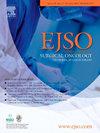实质性淋巴管间隙侵犯对子宫内膜癌患者前哨淋巴结状态和复发的影响:SLYM-EC 多中心回顾性研究
IF 3.5
2区 医学
Q2 ONCOLOGY
引用次数: 0
摘要
材料与方法我们从欧洲14个参考中心连续纳入了接受手术分期和前哨淋巴结造影的明显局限性子宫内膜癌患者。结果在 2352 例符合条件的患者中,1980 例被纳入分析。最终病理结果显示,226 名患者(11.4%)的 SLN 受累。152名患者(7.7%)被诊断为局灶性 LVSI,357 名患者(18.0%)被诊断为实质性 LVSI。与未受 SLNs 影响的患者相比,SLNs 阳性的患者中局灶性或实质性 LVSI 的发生率明显更高(p < 0.0001)。根据对患者的总体分析,LVSI 对前哨淋巴结转移的敏感性、特异性、阳性预测值和阴性预测值分别为 73%、80%、32% 和 96%。3 年无复发生存率的多变量分析显示,只有出现大量 LVSI 和 3 级疾病与复发有关。结论 在接受前哨淋巴结活检的患者中,LVSI阳性在检测SLN受累方面表现出适度的敏感性和合理的特异性。LVSI阳性与结节受累无关。大量LVSI的存在仍然是复发的一个强有力的独立风险因素,这表明早期疾病患者可能存在血行播散。本文章由计算机程序翻译,如有差异,请以英文原文为准。
The impact of Substantial LYMphovascular space invasion on sentinel lymph nodes status and recurrence in Endometrial Cancer patients: SLYM-EC a multicenter retrospective study
Introduction
To evaluate the prognostic impact of substantial lymph vascular space invasion (LVSI) on the sentinel lymph node involvement and recurrence rate of patients with apparent uterine-confined endometrial cancer.
Materials and methods
We enrolled consecutive patients with apparent confined endometrial cancer who underwent surgical staging with sentinel node mapping from 14 European reference centers. LVSI was analyzed semi-quantitatively, according to a 3-tiered scoring system classified as absent, focal, and substantial.
Results
Among 2352 eligible patients, 1980 were included in the analysis. Upon final pathology 226 patients (11.4 %) had SLNs involvement. LVSI was diagnosed focal in 152 patients (7.7 %), whereas 357 patients (18.0 %) showed substantial LVSI. Focal or substantial LVSI rate were significantly higher in patients with positive SLNs when compared to patients without SLNs involvement (p < 0.0001). On overall patient-based analysis, the sensitivity, specificity, positive predictive value, and negative predictive value of LVSI for sentinel lymph node metastases were 73 %, 80 %, 32 %, and 96 %, respectively. The 3-year multivariate analysis of recurrence-free survival showed that only the presence of substantial LVSI, and grade 3 disease were associated with relapse. Neither positive sentinel lymph node, deep myometrial infiltration, nor age at surgery were statistically significant.
Conclusions
In patients having undergone sentinel node biopsy, positive LVSI demonstrated moderate sensitivity and reasonable specificity in detecting SLN involvement. LVSI positivity does not correlate with nodal involvement. The presence of substantial LVSI remains a strong independent risk factor for recurrence, indicating a role for potential hematogenous dissemination in patients with early-stage disease.
求助全文
通过发布文献求助,成功后即可免费获取论文全文。
去求助
来源期刊

Ejso
医学-外科
CiteScore
6.40
自引率
2.60%
发文量
1148
审稿时长
41 days
期刊介绍:
JSO - European Journal of Surgical Oncology ("the Journal of Cancer Surgery") is the Official Journal of the European Society of Surgical Oncology and BASO ~ the Association for Cancer Surgery.
The EJSO aims to advance surgical oncology research and practice through the publication of original research articles, review articles, editorials, debates and correspondence.
 求助内容:
求助内容: 应助结果提醒方式:
应助结果提醒方式:


